QUESTIONS
SECTION A (40 marks)
Answer all questions in this section in the spaces provided.
-
- List two ethical qualities expected of a workshop foreman. (1 mark)
- John studied Power Mechanics at secondary school. He has been offered a job as parts specialist in an automotive spare parts store. Outline three duties he will be expected to perform
(3 marks)
-
- State two safety precautions to be observed by a mechanic when lifting a heavy engine component from the floor (2 marks)
- A stud is labelled 13.2 +0.013 Determine its;
-0.004- minimum and maximum limits
- tolerance
-
- State the purpurse of each of the folding special tools Power Mechanics workshop:
- tachometer (1 mark)
- stethoscope (1 mark)
- Use sketches to differentiate between an external tab washer and an external star washer (2 marks)
- State the purpurse of each of the folding special tools Power Mechanics workshop:
-
- List four non-ferrous metals used in manufacture of motor vehicle components (2 marks)
- State one limitation of using photovoltaic cells in motor vehicle construction (1 mark)
- A four-cylinder engine has a capacity of 1408 cc and a cylinder bore of 80 mm. Calculate its
- swept volume per cylinder (1 mark)
- stroke. (2 marks)
-
- List four types of air cleaners used in motor vehicle fuel systems. (2 marks)
- Describe each of the following methods of mounting carburettors on an engine: (1 marks)
- updraft (1 mark)
- side draft (1 mark)
-
- Outline four procedures that should be undertaken before dismantling a multi-cylinder engine on a work bench, (4 marks)
- List two types of wheel rims used in light vehicles. (1 mark)
-
- State two constructional differences between front-wheel transmission drive and rear-wheel wission drive (2 marks)
- Name two factors that determine the capacity of a conventional motor vehicle battery. (2 marks)
-
- Outline three procedures which should be carried out before lighting oxy-acylene welding equipment. (2 marks)
- Identify two causes of a spongy brake pedal (2 marks)
-
- State two functions of engine mountings (2 marks)
- List two ential features of effective steering gearboxes. (2 marks)
SECTION B (60 marks)
Answer question II on the A3 paper and any other three questions from this section in the spaces provided.
Candidates are advised to spend not more than 25 minutes on question 11.
- Figure 1 shows a machined bracket. Draw, full size, in first angle orthographic projection the following views
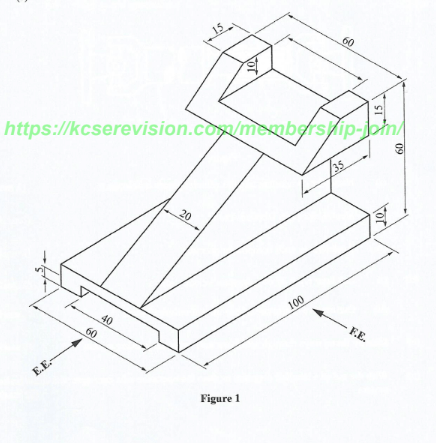
- Front elevation in the direction F.E.
- End elevation in the direction E.E.
- Plan (15 marks)
-
-
- State one function of an engine block. (1 mark)
- Describe the integral type of engine block construction (2 marks)
- Distinguish between 'wer' and 'dry' liners or sleeves used in aluminium engine blocks. (2 marks)
- Explain five operational differences between a two-stroke cycle and a four-stroke cycle petrol engine. (10 marks)
-
-
- Figure 2 shows a motor vehicle component
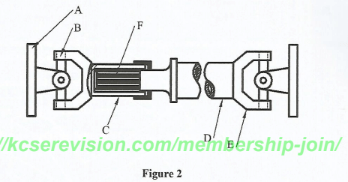
- Name the component and the vehicle system it belongs to. (1 mark)
- Identify the parts labelled A to F. (3 marks)
- Explain how each component operates. (7 marks)
-
- List four types of non-constant velocity joints. (2 marks)
- Outline two indicators of a wom-out universal joint. (2 marks)
- Figure 2 shows a motor vehicle component
-
- Identify three ways through which air may enter the braking system. (3 marks)
- With the aid of a labelled diagram, explain the operation of a cam-operated drum brake system. (12 marks)
-
-
- Sketch a poppet valve and label four parts. (4 marks)
- Identify three common defects associated with poppet valves. (3 marks)
- Explain how the rocker arms of an overhead valve train are lubricated.(4 marks)
- State two factors considered when selecting tyre tread patterns for each of the following road conditions:
- normal touring (2 marks)
- high speed operation (2 marks)
-
MARKING SCHEME
SECTION A
-
-
- Honesty
- Impartial.
- Respect to humanity.
- Obeys the law.
Any 2 x (1 mark) (4 mark)
-
- Ordering parts.
- Storing parts.
- Sourcing and maintaining parts catalog.
- Advising customers on parts requirements.
(Any 3 x 1-(3 marks)
Accept any other correct statements.
-
-
-
- Wearing safety gears.
- Squatting while lifting.
- Firmly gripping the object.
- Not lifting too heavy (above 25kg).
- Operational ares should be free of ohioction. (5 marks)
-
- Minimum limit 13.2-0.004 -13.196-(1⁄2 mark)
Maximum limit 13.2+ 0.013-13.213-(1⁄2 mark) - Tolerance 13.213-13.196=0.017 =(1 mark) or 0.004+0.013=0.017
- Minimum limit 13.2-0.004 -13.196-(1⁄2 mark)
-
-
-
- Tachometer used to measure the speed of an engine in rev/min.(1 mark)
- Stethoscope-used to detect and locate engine noise. (1 marks)
-
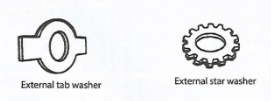
-
-
- Copper, Brass, Zinc, Aluminium, Bronze.
- Limitations
- It is dependent on weather.
- Expensive to install.
- Voluminous: Occupies huge space.
-
- Swept volume = 1408
4
= 352cc - Stroke =Swept Volume
π2
= 352
3.14x(4.0)2
=7.0 cm or 70 mm
- Swept volume = 1408
-
-
- Oil wetted polyurethane
- Oil bath.
- Paper cartridge or element.
- Wire mesh.
- Foam type.
(Any 4x 1⁄2 marks)
-
- Updeall-carburetor mounted below the intake manifold
- Side draft carburetor mounted on the side of the intake manifold
-
-
-
- Disconnecting all accessories and auxiliary services.
- Draining engine oil,
- Removing the radistor
- Removing air cleaner
- Loosening and removal of bell housing.
- Support engine linnly for safet
-
- Pressed steel wheels
- Allow wheels
- Wire spoked wheels
- Sports wheels
-
-
-
Front wheel Rear wheel Drive at the front Drive at the rear Has drive shaft Has propeller shaft Very compact Occupies more space Lower floor bas High floor plac -
- Size of the plates
- Number of the plates
- Amount of acid in the electrolyte
Any 2x1-2 marks
-
-
-
- Ensure the cylinders are vertical and firmly fastened to trolle.
- Check that all the equipment are properly assembled and that the torch valves are closed.
- Set the regulators to the correct working pressure
- Loosen the acetylene and oxygen valves
- Open the acetylene valve first, light up then open the oxygen v Ive to enable you adjust to the correct flame
-
- Air in the hydraulic system
- Vapor in the system
- Ballooning hose
-
-
-
- Isolates engine vibrations and prevents their transfer to the body of the car
- Erases torque loading of the drive line
-
- Should enable the driver to feel road conditions when driving
- Should prevent excessive road shocks being transmitted to the steering wheel
- Should ensure that free play (backlash) at the steering wheel is kept to the minimum
- Gear reduction leading to increase in torque.
Any 2x1=2 marks
-
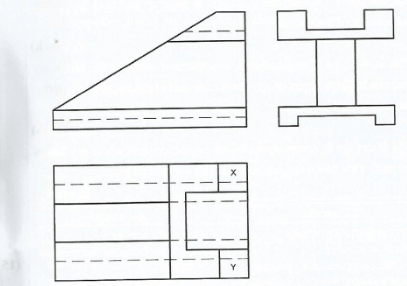
Front elevation
3 faces x 1=3 marks
1 set of hidden details 1 mark
End elevation
3 faces x 1-3 marks
Plan
5 faces x1=5 marks
(ignore faces X and Y)
2 sets of hidden details=2 marks
Sub-total 7 marks
1" angle projection 1 mark
Total 15 marks-
-
- Engine block-houses the cylinders in position and thus facilitates movement of the piston.
- This is the type of engine block construction whereby the block extends to form a part of the crankcase and therefore also supports the crankshaft bearings.
- Wet liners are in direct contact with engine coolant while dry liners are not. Dry liners are pressed into the completed block.
-
2-stroke 4- stroke piston performs two tasks
-Acts as a valve
-Is the compressor in primary and secondary compressionsPiston only acts as a compressor because the engine has valves Mixture comprises of petrol and lubricating oil Mixture comprises of petrol and air only Engine has two compressions
- primary and secondaryEngine has only one compression Engine produces ONE power stroke for every revolution of crankshaft Engine produces ONE power stroke for every two revolutions of the crankshaft Not all exhaust gases are cleared from the combustion chamber, hence preventing fresh charge from entering the cylinder nearly all burnt gases are cleared, thus allowing more fresh charge to enter the cylinder Highest fuel consuption because of high scavenging Lower fuel consuption because of lower scavenging.
-
-
-
- Propeller shaft: transmission system
- A Drive plate B - cross or spider
C-Sliding joint D-Tube
E-Yoke F Splines - Operation
- Since the gearbox and the differential drive pinion are install dat an angle to the horizontal (1), the propeller shaft, being the linking member between the two, is also installed at an angle called universal joint operating angle (1)
- As the final drive moves up and down due to road irregularitie the drive shaft length changes (1) thus changing the operating angle (1)
- To allow for up and down movement of the final drive, the https:/popshaft mit fes (1) and this facilitated by the un versal joint
- The drive shaft also lengthens and shortens due to road conditions.
- This is facilitated by the slip joint (1)
-
- Cross and yoke Rubber trunnion; flexible fabric; layrub
-
- Squeaking noise when starting to move vehicle forward
- Vibration felt throughout the vehicle while moving forward at moderate to high speed
- Leakage of transmission fluid from the rear of the transmissio
- Dislocation of drive shaft, immobilizing the vehicle
-
-
- Through:
- Defective master cylinder
- Loose connections
- Damaged tubes
- Loss of brake flui
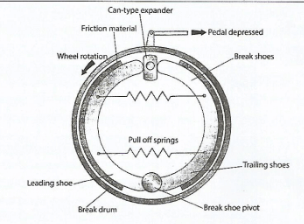
Operation- When the brake pedal is depressed, pulls the opening even which in turn rotate the cam(1)
- The rotating cam forces the two brake shoes apart until they press against the inside of the dram (1)
- The friction caused between the shoe linings and the drum slows down the vehicle (1)
- When the brake pedal is released, the cam returns to its original position (1) and the shoes are pulled away from the drums by the return springs (1)
- Through:
-
-
-
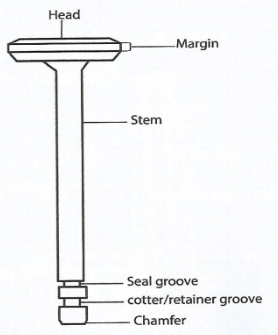
- Common defects
- Pitted or wom face
- Carbon deposits glued on face
- Bent or worn stem
- No margin
- Cracked or but face
-
- Since most engines have hollow rocket shafts, to lubricate the rocker arm, oil is supplied through the hollow rocker shaft (1) to the rocker an bushing through drilled passages in the rocker arm to the ball(1) sockets. The oil is delivered to the rocker arm shaft through special oil lines in the cylinder block (1) and head. For engines using individual rocker arm studs, the oil is usually supplied through (1) hollow push rods.
-
- Normal touring requires a tread which gives:
- quiet operation
- provides effective adhesion under wet, dry and greasy condit ons.
- High speed operation requires a tread that can:
- Withstand high heat generated
- Give quieter operation
- Resist aquaplaning.
- Normal touring requires a tread which gives:
-
Download Power Mechanics Paper 1 Questions and Answers - KCSE 2022 Past Papers.
Tap Here to Download for 50/-
Get on WhatsApp for 50/-
Why download?
- ✔ To read offline at any time.
- ✔ To Print at your convenience
- ✔ Share Easily with Friends / Students
